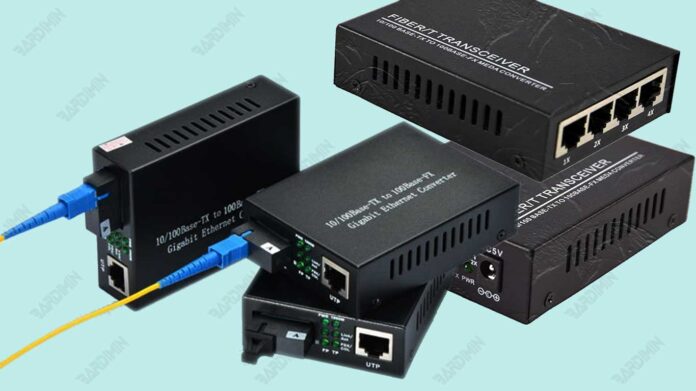A media converter is a hardware device used to change the format or type of data transmission media from one type to another. It can be used in the context of computer networks to convert signals between two different kinds of media, such as optical fiber and copper wires.
The importance of a media converter in connecting different types of networks lies in its ability to provide interoperability between devices using different media.

Benefits of Media Converters
Media converters are necessary in network infrastructure because they allow the integration of devices that use different media. Some of the main benefits of using a media converter are:
- Interoperability: Media converters allow devices that use different transmission mediums to connect and communicate within the same network. For example, using a media converter, you can connect a device that uses copper wires with a device that uses fiber optics.
- Flexibility: Media converters allow flexibility in network design. They will enable the use of different types of transmission media according to the specific needs of the network, such as distance, speed, or reliability.
Here are some examples of situations where the use of media converters is particularly relevant:
- New network integration with existing infrastructure: For example, if you want to connect an existing copper cable network with a new fiber optic network, you can use a media converter to convert signals between the two without needing to replace the entire infrastructure.
- Network coverage expansion: If you need to extend your network coverage beyond the limit of the distance that can be reached by one type of transmission medium, a media converter can be used to convert the signal to a media type that better suits the required distance, such as from optical fiber to copper wire.
Thus, media converters play an important role in enabling efficient and flexible connectivity within modern computer networks.
Jenis-Jenis Media Converter
Media converters come in different types, each with its functions and uses. Here are some common types of media converters along with a more detailed explanation, examples of use, and considerations in choosing one:
1. UTP of fiber optic (Copper)
Fiber Optic to UTP converter media converts signals from fiber optic cables into signals that can be used by copper twisted-pair cables (UTP). This is especially useful in situations where you want to connect a device that only has a UTP port to a fiber optic network that offers superior coverage and speed.
Examples of use:
- It connects servers in the data room to switches in the network room via fiber optic cables and UTP media converters, enabling high-speed long-distance data transfer.
- Connecting outdoor security cameras to the NVR network inside the building via fiber optic cable and UTP media converter, ensures stable and secure video transmission.
2. Single Mode to Multimode
Fiber optic cables are divided into two types, namely single mode and multimode. Each type of cable has its characteristics and uses. Single mode to multimode media converters are used to connect these two types of fiber optic cables, bridging the differences between them.
Difference between single mode and multimode:
- Distance: Single-mode cables can transmit data over long distances, such as several kilometers, ideal for wide-area networks (WANs). Multimode wires, on the other hand, are limited to shorter distances, about a few hundred meters, suitable for local area networks (LANs).
- Bandwidth: Single-mode cables have higher bandwidth, allowing for faster data transmission. Multimode cables have lower bandwidth but are still sufficient for general networking needs.
- Cost: Single-mode cables are generally more expensive than multimode cables.
Advantages and use of media converter single mode to multimode:
- Extend network coverage: This media converter allows you to connect remote devices that cannot be reached with a multimode cable, ideal for extending the network to other buildings or remote locations.
- Increase bandwidth: This media converter can be used to increase network bandwidth by using a single-mode cable, allowing faster data transfer for applications that require high bandwidth.
- Reduce costs: These media converters can help you save money by allowing you to use cheaper multimode cables for shorter distances, and only use single-mode cables for segments that require long distances and high bandwidth.

